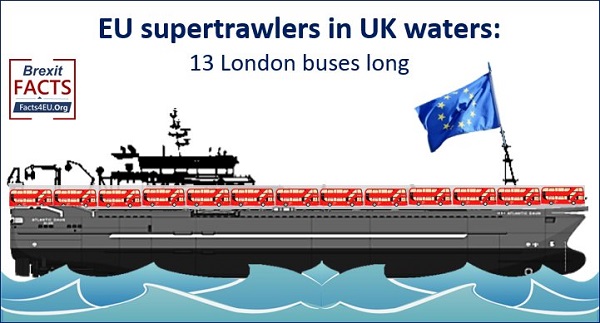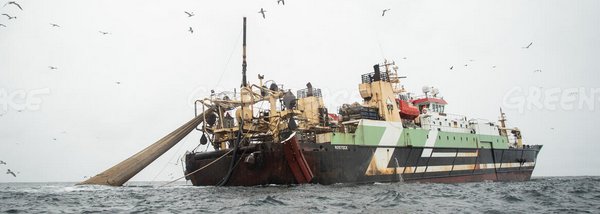UK licenses EU supertrawlers which broke EU laws
Just 100 EU ships account for over 50% of tonnage of EU fleet allowed in UK waters

Montage © Facts4EU.Org 2021
EU’s ‘factory ships’ and ‘supertrawlers’ plough British waters, under the EU trade treaty
Out of the 1,700 licences the UK has issued to EU vessels to allow them to continue fishing in UK waters after Brexit, the largest of these is for a ship that is enormous.
The Annalies Elena carries the Polish flag, is Dutch-owned, and is 472 feet long (144m) with a gross tonnage of over 14,000 tonnes. Its length is the equivalent of 13 London Routemaster buses laid end-to-end. Permitted to fish in Brexit Britain’s waters, it has been prosecuted by EU member country Ireland and is unwelcome in certain other jurisdictions around the world.
The second-largest, the Margiris, carries the Lithuanian flag, is 469ft long (143m) and has a gross tonnage of 9,500 tonnes. Current maritime geo-positioning shows this ship to be in the North Sea as of the time of writing (4am, Tues 05 Oct 2021).
Brexit Facts4EU.Org Summary
EU fishing fleet’s tonnage now licensed for UK waters in 2021
- Total tonnage of EU fishing fleet licensed for UK waters : 425,265 tonnes
- Total tonnage of UK fishing fleet after decades of EU Common Fisheries Policy: 203,703 tonnes
- EU’s fleet by sheer tonnage, licensed for British waters, is twice the size of the UK’s in the UK's own waters
- 25% of EU tonnage is accounted for by 1% of the EU vessels (18 ships)
- 40% is accounted for by less than 3% of the vessels (50 ships)
- 50% is accounted for by less than 6% of the vessels (100 ships)
- The largest EU ship licensed by the UK is the equivalent of 13 London buses laid end-to-end
- It is longer than a football pitch and its nets cover an area of more than 450 tennis courts
The 25 largest EU trawlers licensed to fish in British waters in 2021
© Brexit Facts4EU.Org - click to enlarge
[Data source: The official UK Government agency, the Marine Management Organisation.]
To give some perspective to what follows, smaller fishing boats are around 1-5 tonnes
The fourth-largest EU super-trawler licensed by British authorities this year is the Maartje Theadora, a German-registered vessel with over 9,000 tonnes gross weight. In 2012 it was prosecuted by the French (of all countries) and fined over £0.5 million for breaking EU law. It was stopped with £1m pounds’ worth of illegally-caught fish.
Here it is in the English Channel just three weeks ago.
Above: The Maartje Theadora in the English Channel, 12 Sep 2021, credit: Greenpeace
EU’s ‘factory ships’ and ‘super trawlers’ ploughing British waters
[IMPORTANT: Firstly we must stress that there is no suggestion that any of the ships mentioned have broken any UK laws. With UK fishing licences having been granted they are free to sail within the UK's 'Exclusive Economic Zone', which extends to 200 nautical miles from the coast.]
Out of almost 1,700 fishing licences which the UK has issued to EU boats, there are enormous factory ships or ‘super-trawlers’ which dominate fishing. For many years their fishing methods and the sheer scale of their activities have been causing immense concern to other fishermen and to marine conservationists.
Whilst the UK Government has talked about banning these EU ships, they were all granted licences this year to allow them to continue ploughing United Kingdom waters, including marine conservation areas from Scotland to the Isle of Wight. In today’s report Facts4EU.Org is providing some simple facts based on our detailed analysis of the latest licensing figures released by the Government’s Marine Management Organisation last week.
What are ‘factory ships’ or ‘super trawlers’?
There are no accepted official definitions for either of these terms. Descriptions, lengths, and tonnages vary according to the part of the world and the organisations writing about them.
Below is the Helen Mary, number five on our list above. The Helen Mary is a German-registered supertrawler some 117m long, fishing in the North Sea in October 2020, courtesy of Greenpeace.
© Suzanne Plunkett / Greenpeace
In general terms we are talking about massive boats, many of which have full capabilities on board for the automated processing of the daily catches, as well as their chilling and freezing. These ships can stay at sea for up to two months at a time and can produce daily catches of over 300 tonnes per day. Their nets can be up to 1950 ft long by 650 ft wide (600m x 200m).
EU ‘fishing boats’ larger than Royal Navy’s guided missile frigates
For the purposes of this article we initially decided to look at EU ships licensed by the UK authorities which have a gross weight in excess of that of a British Type 23 guided missile frigate (4,900 tonnes displacement), as this is quite a beast.
(Note: Military ships are generally described by their ‘displacement’, which is the way of calculating their total weight. Conversely, gross tonnage is used for commercial shipping and refers only to the storage capacity, not the entire weight of the ship and its contents, so our figures are very conservative.)
It then became clear that a wider picture was emerging, of more than half the EU fishing fleet’s total tonnage being accounted for by just 100 boats. That’s not even 6% of the total number of licences which the UK Government’s agency has issued to EU vessels to fish in British waters.
Observations
'Plenty more fish in the sea?'
The EU (and in particular France) is currently threatening the UK over a few licences being held up for very small French boats due to them not having the correct paperwork, despite them having been given extensions to provide it.
It must be said that the French and EU threats are wholly unreasonable, given the way that the post-Brexit UK has continued to allow the EU to take extraordinary quotas of UK fish, which for some species are more than 80%. In addition the UK has been more than generous in granting licences to the world’s largest supertrawlers, which carry the flags of EU countries, and which have been banned by countries such as Australia.
Our report above shows the industrial scale of fishing that has been pursued by some EU countries, in some cases with little care for the marine environment, according to conservationists. Meanwhile, the UK’s more localised fishing industry has been devastated by the EU’s Common Fisheries Policy for decades. This has not only meant UK fishermen from Scotland to Cornwall leaving the industry, it has also had a severe knock-on effect for the coastal communities which have traditionally relied on their fishing fleets to help to drive the local economies.
It remains a source of complete surprise to many people when they learn that the UK, an island nation surrounded by the richest seas in the world, is a net importer of fish from the EU, by a long margin.
It will take the UK fishing industry many years to recover from EU membership, but the time to start this is now. And a good start would be for the Government to move fast to ban super-trawlers from UK waters.
Facts4EU.Org needs you today
We are a 'not for profit' team (we make a loss) and any donation goes towards the actual work, not plush London offices, lunch or taxi expenses, or other luxuries of some organisations.
We badly need more of our thousands of readers to donate. Could this be you, today? Maybe you've been thinking about it, but just haven't got around to doing it? If so, let us reassure you. It's quick and easy and we use two highly secure payment providers. And we do NOT ask you for further donations if you donate once - we just hope that you keep supporting us. Your donation stays anonymous unless you tell us otherwise.
Please don't assume that other people will keep us going - we don't receive enough to survive and we need your help today. Could you help us?
Most of our readers are well-informed and appreciate our fact-based articles, presented in a way you won't see anywhere else. If you value reports like the one above, please help our work with a donation. We have far more to do in researching, publishing, campaigning and lobbying Parliament than we have in terms of the financial resources to fulfil these tasks. We badly need funding to continue - we rely 100% on public donations from readers like you.
If you believe in a fully-free, independent, and sovereign United Kingdom, please make a donation now. It’s quick, secure, and confidential, and you can use one of the links below or you can use our Donations page here. You will receive a personal, friendly ‘thank you’ from a member of our team within 24 hours. Thank you for reading this.
[Sources: UK Marine Management Organisation 2021 | Vessel Finder | French media | Australian media | British Sea Fishing | International Tennis Federation (for comparison with tennis court area) | Transport for London (for comparison with London buses) | House of Commons Library research papers | Greenpeace] Politicians and journalists can contact us for details, as ever.
Brexit Facts4EU.Org, Tues 05 Oct 2021
Click here to go to our news headlines
Please scroll down to COMMENT on the above article.
And don't forget to actually post your message after you have previewed it!
Since before the EU Referendum, Brexit Facts4EU.Org
has been the most prolific researcher and publisher of Brexit facts in the world.
Supported by MPs, MEPs, & other groups, our work has impact.
We think facts matter. Please donate today, so that we can continue to ensure a clean Brexit is finally delivered.
Paypal Users Only - Choose amount first
Quick One-off
Monthly





Something to say about this? Scroll down for reader comments